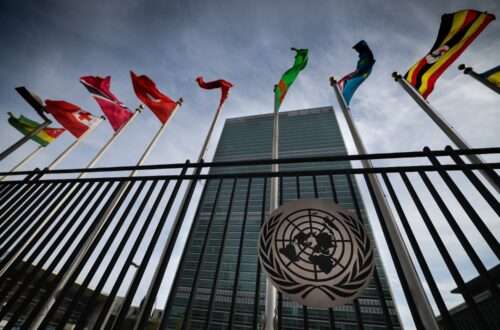Prime Minister Benjamin Netanyahu on Saturday hailed as a “major development” a newly announced US-backed plan to build a rail and shipping corridor linking India with the Middle East, Israel and Europe.
The corridor is an ambitious project aimed at fostering economic growth and political cooperation and would help to boost trade, transport energy resources and improve digital connectivity.
Netanyahu called the initiative “a cooperation project that is the greatest in our history” and one that “takes us to a new era of regional and global integration and cooperation, unprecedented and unique in its scope.”
In a video message, Netanyahu said the new corridor “will bring to fruition a years-long vision that will change the face of the Middle East and of Israel.
“Our country Israel will be a central junction in this economic corridor, our railways and our ports will open a new gateway from India through the Middle East to Europe, and back.”
He thanked Biden and his administration “for the great effort that brought us to this historic announcement.”
And he promised that Israel “will muster all its capabilities, all its experience, with full forward momentum and commitment… to make this dream a reality.”

Illustrative: Railway tracks near Karmiel in northern Israel, on November 8, 2017. (Hadas Parush/Flash90)
Netanyahu had previously discussed the possibility of a train linking Israel to Saudi Arabia.
Related: PM unveils planned Kiryat Shmona-Eilat fast rail, says could link to Saudi Arabia too
Saudi Arabia and Israel do not have diplomatic relations, though the White House has been pushing them toward normalizing relations.
US National Security Adviser Jake Sullivan said Saturday that the transportation project is not seen as a “precursor” to a potential normalization deal but he characterized Israel’s inclusion as “significant.”
“The participants in this effort are focused on practical outcomes that deliver for their people,” Sullivan said. “And a corridor of this kind by dint of geography works best having Israel in as opposed to out and the countries participating prioritized that.”

White House national security adviser Jake Sullivan speaks during the daily briefing at the White House in Washington, Sept. 30, 2022. (AP Photo/Susan Walsh)
Foreign Minister Eli Cohen said Saturday his office was “continuing in its efforts to connect the countries of the Abraham Accords and Israel, which will shorten in an unprecedented manner the time it takes to transfer goods through the Gulf states to Israel and from there to Europe, and will significantly reduce shipping costs.
“This is part of the vision of regional peace and another result of the Abraham Accords, which were signed three years ago and are changing the face of the Middle East, encouraging stability and prosperity for the peoples of the region and reducing the cost of living for Israelis.”
The corridor would include India, Saudi Arabia, the United Arab Emirates, Jordan, Israel and the European Union, said Sullivan.
US President Joe Biden and his allies announced the plans alongside Indian Prime Minister Narendra Modi and European Commission President Ursula von der Leyen during the annual Group of 20 summit of the world’s top economies. It is part of an initiative called the Partnership for Global Infrastructure Investment.
“This is a big deal,” said Biden. “This is a really big deal.”

Saudi Arabian Crown Prince Mohammed bin Salman Al Saud, left, and US President Joe Biden, right, shake hands next to Indian Prime Minister Narendra Modi on the day of the G20 summit in New Delhi, India, September 9, 2023. (AP Photo/Evelyn Hockstein, Pool)
“We think that the project itself is bold and transformative, but the vision behind the project is equally bold and transformative, and we will see it replicated in other parts of the world as well,” Sullivan said.
The rail and shipping corridor would help to physically tie together a vast stretch of the globe, improving digital connectivity and enabling more trade among countries, including with energy products such as hydrogen. Although White House officials did not set a timeline for its completion, the corridor would provide a physical and ideological alternative to China’s own nation-spanning infrastructure program.
The White House gave no details on how the project would be paid for.
Sullivan said the network reflected Biden’s vision for “far-reaching investments” that come from “effective American leadership” and a willingness to embrace other nations as partners. He said the enhanced infrastructure would boost economic growth, help bring countries in the Middle East together and establish that region as a hub for economic activity instead of as a “source of challenge, conflict or crisis” as it has been in recent history.
Von der Leyen described the project as a “green and digital bridge across continents and civilizations.” She added that it includes cables to transmit electricity and data.
She also announced a “Trans-African Corridor” connecting the Angolan port of Lobito with landlocked areas: the Kananga province in the Democratic Republic of Congo and the copper-mining regions of Zambia.
Speaking of the African project, Biden called it a “game-changing regional investment” and said “both of these are huge, huge steps forward.”
Amos Hochstein, Biden’s coordinator for global infrastructure and energy security, laid out a rough timeline for the project over the next year.
In the next 60 days, working groups will put together a fuller plan and set timelines. The first phase will involve identifying the areas that need investment and where physical infrastructure can be connected between countries. Hochstein said the plans can be put into place over the next year so that the project can move onto setting up finances and construction.
Sullivan said the project started coming together after Biden visited Jeddah, Saudi Arabia, in July 2022, where he emphasized a need for greater regional economic integration.
In January, the White House started having conversations with regional partners about the concept. By spring, maps and written assessments of existing rail infrastructure in the Middle East were being drafted. Sullivan, and senior White House aides Hochstein and Brett McGurk, traveled to Saudi Arabia in May to meet with their Indian, Saudi and UAE counterparts.
All sides have worked since then to finalize details of the agreement announced Saturday.






